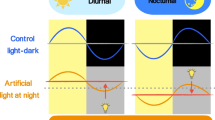Phototherapy (therapy with bright light) is widely used to treat seasonal affective disorders, different types of depression, sleep disorders, and other diseases; it has no significant contraindications, but its effects on functional state and biological rhythms of the cardiovascular system in hypertension are poorly studied. In experiments on Wistar-Kyoto and SHR (spontaneously hypertensive rats) rats, the effect of bright light therapy on the daily profile of BP, HR, and production of epiphyseal melatonin was investigated. Phototherapy was simulated by exposure to 9000-lux cold light at the level animal eyes over 1 h (from 10.00 to 11.00 h) with LED lamps. In freely moving rats (free access to food), daily profiles of BP and HR were studied by 24-h continuous telemetry monitoring. The production of epiphyseal melatonin was assessed by measuring urinary concentration of its stable metabolite 6-sulfatoxymelatonin (aMT6s) during the day and night. During phototherapy, systolic BP significantly increased in in animals of both lines and diastolic BP increased in SHR rats. This effect persisted after the end of phototherapy session. Bright light had no effect on HR. In Wistar-Kyoto rats, phototherapy induced a significant decrease in daily concentration of aMT6s, but its nocturnal level did not change. In SHR rats, bright light therapy significantly decreased nighttime concentration of aMT6s in the urine and had no effect on daytime concentration of this metabolite. As a result, the difference between the night and day levels of aMT6s in the urine was leveled. Phototherapy produced more pronounced and less favorable effect on animals with primary arterial hypertension.
Similar content being viewed by others
References
Melatonin: Theory and Practice. Rapoport SI, Golichenkov VA, eds. Moscow, 2009. Russian.
Abeysuriya RG, Lockley SW, Robinson PA, Postnova S. A unified model of melatonin, 6-sulfatoxymelatonin, and sleep dynamics. J. Pineal Res. 2018;64(4). ID e12474. doi: https://doi.org/10.1111/jpi.12474
Amaral FGD, Cipolla-Neto J. A brief review about melatonin, a pineal hormone. Arch. Endocrinol. Metab. 2018;62(4):472-479.
Beauchamp MT, Lundgren JD. A systematic review of bright light therapy for eating disorders. Prim. Care Companion CNS Disord. 2016;18(5). doi: https://doi.org/10.4088/PCC.16r02008
Danilenko KV, Mustafina SV, Pechenkina EA. Bright light for weight loss: results of a controlled crossover trial. Obes. Facts. 2013;6(1):28-38.
Fernandez DC, Fogerson PM, Lazzerini Ospri L, Thomsen MB, Layne RM, Severin D, Zhan J, Singer JH, Kirkwood A, Zhao H, Berson DM, Hattar S. Light affects mood and learning through distinct retina-brain pathways. Cell. 2018;175(1):71-84.e18.
Lazzerini Ospri L, Prusky G, Hattar S. Mood, the circadian system, and melanopsin retinal ganglion cells. Annu. Rev. Neurosci. 2017;40:539-556.
Maruani J, Geoffroy PA. Bright light as a personalized precision treatment of mood disorders. Front. Psychiatry. 2019;1(10). ID 85. doi: https://doi.org/10.3389/fpsyt.2019.00085
Schwartz RS, Olds J. The psychiatry of light. Harv. Rev. Psychiatry. 2015;23(3):188-194.
Takeda N, Maemura K. Circadian clock and cardiovascular disease. J. Cardiol. 2011;57(3):249-256.
van Maanen A, Meijer AM, van der Heijden KB, Oort FJ. The effects of light therapy on sleep problems: A systematic review and meta-analysis. Sleep Med. Rev. 2016;29:52-62.
Videnovic A, Klerman EB, Wang W, Marconi A, Kuhta T, Zee PC. Timed light therapy for sleep and daytime sleepiness associated with Parkinson disease: a randomized clinical trial. JAMA Neurol. 2017;74(4):411-418.
Yamada N, Martin-Iverson MT, Daimon K, Tsujimoto T, Takahashi S. Clinical and chronobiological effects of light therapy on nonseasonal affective disorders. Biol. Psychiatry. 1995;37(12):866-873.
Yorguner Kupeli N, Bulut NS, Carkaxhiu Bulut G, Kurt E, Kora K. Efficacy of bright light therapy in bipolar depression. Psychiatry Res. 2018;260:432-438.
Zuther P, Gorbey S, Lemmer B. Chronos-Fit 1.06, 2009. URL: http://chronos-fit.sharewarejunction.com
Author information
Authors and Affiliations
Corresponding author
Additional information
Translated from Byulleten’ Eksperimental’noi Biologii i Meditsiny, Vol. 168, No. 8, pp. 166-170, August, 2019
Rights and permissions
About this article
Cite this article
Blagonravov, M.L., Bryk, A.A., Goryachev, V.A. et al. Bright Light Therapy Increases Blood Pressure and Changes the Structure of Circadian Rhythm of Melatonin Secretion in Spontaneously Hypertensive Rats. Bull Exp Biol Med 168, 214–218 (2019). https://doi.org/10.1007/s10517-019-04677-9
Received:
Published:
Issue Date:
DOI: https://doi.org/10.1007/s10517-019-04677-9



